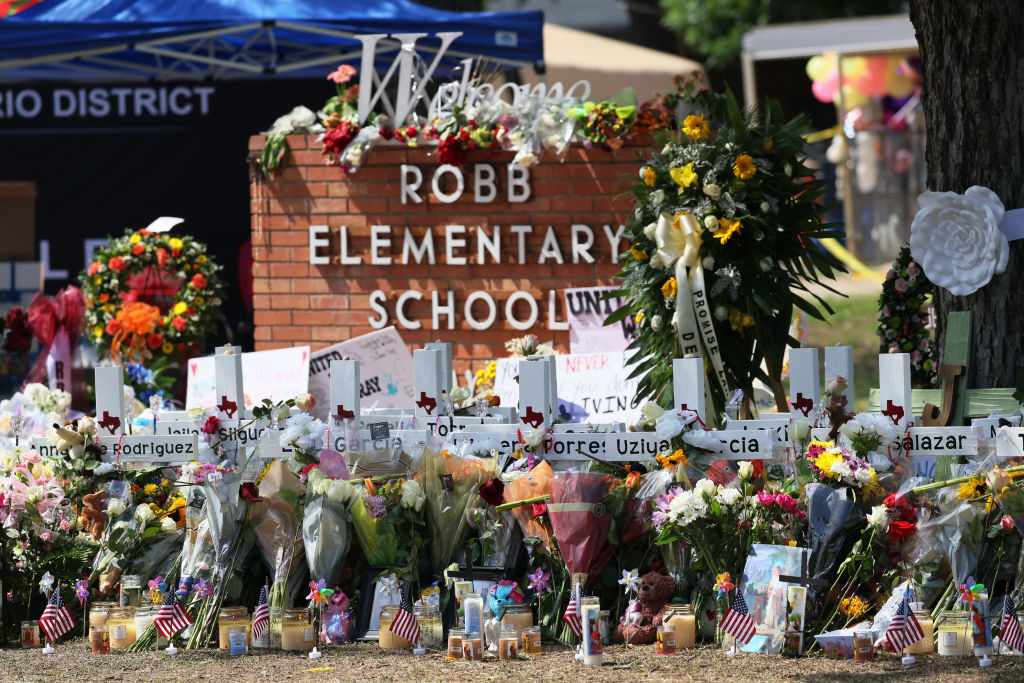
UVALDE, TEXAS – MAY 27: A memorial for the victim’s of Tuesday’s mass shooting at Robb Elementary School is seen on May 27, 2022 in Uvalde, Texas. Steven C. McCraw, Director and Colonel of the Texas Department of Public Safety, held a press conference to give an update on the investigation into Tuesday’s mass shooting where 19 children and two adults were killed at Robb Elementary School, and admitted that it was the wrong decision to wait and not breach the classroom door as soon as police officers were inside the elementary school. (Photo by Michael M. Santiago/Getty Images)
Mistakes were made during the police response at Robb Elementary School in Uvalde, according to Texas Public Safety Director Steven McCraw. On the day Salvador Rolando Ramos killed 19 students and two teachers, he entered the building uncontested and remained inside for almost an hour-and-a-half before a Customs and Border Protection tactical team breached the room and shot him. Many wonder if different decisions by those first on the scene could have saved lives and if the officers followed active shooter procedures or ignored them.
What We Know – As of Now
 It’s always difficult to figure out exactly what happened when after a shooting, but the timeline in this case seems to be more muddled than most. As Liberty Nation’s Mark Angelides explained earlier, “Ambiguity in the official version of events is increasing, with clarifications from authorities contradicting many earlier statements.” Over the course of Friday, May 27, after those words were written, even more clarifications were issued. What all that means is simple: The story has changed often, and what we think happened may still not be entirely accurate. Barring any further contradictory clarifications, this is what we know:
It’s always difficult to figure out exactly what happened when after a shooting, but the timeline in this case seems to be more muddled than most. As Liberty Nation’s Mark Angelides explained earlier, “Ambiguity in the official version of events is increasing, with clarifications from authorities contradicting many earlier statements.” Over the course of Friday, May 27, after those words were written, even more clarifications were issued. What all that means is simple: The story has changed often, and what we think happened may still not be entirely accurate. Barring any further contradictory clarifications, this is what we know:
Salvador Ramos shot his grandmother in the face after arguing over his phone bill, then stole her truck and drove erratically across town, eventually crashing into the ditch just outside Robb Elementary School. He then abandoned the vehicle – firing on two unsuspecting civilians across the street but missing both – and made his way toward the school. The Uvalde Consolidated Independent School District police officer, who was off campus at the time, responded to a 911 call of a man with a gun at the school but drove past the suspect, who hid behind a car in the parking lot.
Ramos fired multiple shots at the school building from outside, shooting through the window and into a classroom. He then entered the building at 11:33. Just minutes before, a teacher had propped a door open and, after watching the crash and the shooter’s emergence from the vehicle, went back inside and placed the 911 call that summoned the school’s officer. She left the door propped open, which is how the killer gained entry.

(Photo by Michael M. Santiago/Getty Images)
The gunman then went to adjoining classrooms 111 and 112, where he continued shooting. By 11:35, seven officers were on the scene and in the hallway, where two were grazed by bullets through the allegedly locked classroom door. Ramos then fired 16 shots inside the classrooms from 11:37 to 11:44 as more officers arrived. By 12:03 pm, there were 19 officers in the hallway, yet they remained outside the room, waiting for a tactical team and more equipment.
At 12:03, a student from inside the classrooms called 911. She was on the line for one minute and 23 seconds. She called back at 12:10 to report that there were multiple people dead, then again three minutes later. Still, the officers remained outside.
At 12:15, members of BORTAC, the Border Patrol tactical team, arrived with shields. But still, they waited. The same girl called back at 12:16 to say that only eight people were left alive in the classroom. Another student called 911 but hung up. Three shots were heard over a 911 call from inside the classroom at 12:21, and yet the police and federal agents were still stationed in the hall, with more outside the building, holding back the crowd – many of whom were parents of students inside, and some of whom were volunteering to take officers’ weapons and vests and go in and end it themselves.
According to Public Safety Director McCraw, more than 100 rounds had been fired in the first few minutes, but that gunfire was sporadic after that, and aimed at the door. It’s unclear whether or not any additional victims inside the classrooms were shot during this “sporadic” period. Another student called 911 at 12:36, then again at 12:43. At 12:47, she asked 911 to send in help. At 12:50, the tactical team, who had acquired keys from the janitor, entered the room and shot the suspect. There were still students alive inside, but quite possibly because Ramos didn’t know. More than one child later reported smearing the blood of the fallen on themselves and pretending to be dead.
Active Shooter Protocol – What Wasn’t Done?
Various police departments across the nation have posted their own active shooter protocols, and while the wording sometimes varies, the general idea is the same: Don’t wait – get in there and stop the shooting as soon as possible. Just two months before the shooting, Uvalde’s school district held an all-day training session for local police and other school-based law enforcement officers focused on active shooter response. “First responders to the active shooter scene will usually be required to place themselves in harm’s way,” the course description posted online explained. “The best hope that innocent victims have is that officers immediately move into action to isolate, distract or neutralize the threat, even if that means one officer acting alone.”

According to McCraw, the chief of the school district’s police department made the call to wait. He said that after the shooter barricaded himself in the room, the incident commander may have believed there were no more students left alive inside and that it was therefore no longer an active shooter situation. McCraw calls this “the wrong decision, period,” but says he knows this “from the benefit of hindsight where I’m sitting now.” Other officers focused on evacuating students from the building, even as more shots were being fired.
The door shouldn’t have been propped open – or left that way after the teacher who did it saw an armed man coming toward the school. The officer shouldn’t have been off campus. These things are clear in hindsight. As for the police response in the thick of it – which is being investigated by the Texas Rangers and the FBI – some experts disagree. John Cohen, a former police officer and counterterrorism official at DHS, told ABC News that this response “would seem inconsistent with accepted practice.” Steve Ijames is a retired police chief who has offered SWAT, use of force, counter terror, and active shooter response training on behalf of the International Association of Chiefs of Police and the US State Department all across the US and in 33 other countries as well. “The protocol is, as soon as you determine there is an active shooter you don’t wait for anyone,” Ijames told NPR. “You enter and move [to] neutralize and it may be at your peril. It’d be great if you had some help – but I can assure you those kids need help more than you need help.”
Things likely to be evaluated in the investigation include why the exterior door was propped open, why the officer was off campus and why he didn’t see the suspect on approach, whether the initial 911 call revealed enough accurate information, and whether the dispatcher properly conveyed information – from the first call and those that followed – to the officers on site. Of course, the investigation will likely also cover the police chief’s thought process and his orders to wait, as well as whether the BORTAC team was incapable of breaching the door without the janitor’s keys and why. A great many things went wrong that Tuesday in Uvalde. Perhaps the investigation can reveal what could and should have been done differently. It will do the victims no good, of course – but the lives of those in future shootings may depend on it.
Remember to check out the web’s best conservative news aggregator
Whatfinger.com — the #1 Alternative to the Drudge

